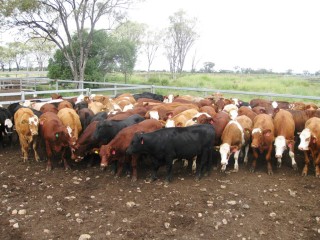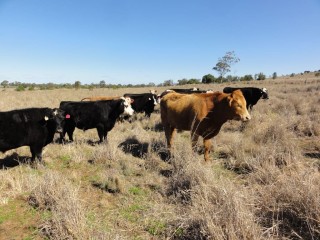U.s.a Beef Cattle Pasture Finishing System
 As the colder months set in and daily weight gains become difficult to achieve from grassfed cattle, a Producer Demonstration Site (PDS) in southern Queensland has provided a timely and commercially-relevant insight into how cattle can perform on different finishing systems over winter.
As the colder months set in and daily weight gains become difficult to achieve from grassfed cattle, a Producer Demonstration Site (PDS) in southern Queensland has provided a timely and commercially-relevant insight into how cattle can perform on different finishing systems over winter.
Over the past two years, the PDS at Ranald and Sally Ferrier's property Bannockburn near Bell has compared the economic performance of common groups of cattle split several ways into finishing systems that have improved pasture, elevated leucaena, oats and an on-property feedlot as components.
Cattle assessed in the PDS were purchased from three vendors, with 87 EU (non HGP) steers bought from the Roma district and assessed over a 364 day period in 2011 (commenced 12 Nov 2010), and 100 EU steers purchased from the Tenterfield and Mitchell districts and assessed over 320 days in 2012 (commenced 1 Dec 2011) – the 2012 trial was shortened due to a lack of rainfall in the second half of the year.
Results from both years were discussed at a field day at Bannockburn last Friday, and provide an independent assessment of the relative profitability of each finishing system.
Ranald Ferrier said a key aspect of the trial was the integrity of the data collected. Every single animal was weighed upon entry, then weighed religiously every 8-10 weeks, and then weighed and valued at exit, either via a meatworks kill price or by an estimated paddock value.
 "You hear people looking at paddocks and saying the cattle are doing well, and maybe putting the odd one over the scales, but this is hard data overseen by a third party," Mr Ferrier said.
"You hear people looking at paddocks and saying the cattle are doing well, and maybe putting the odd one over the scales, but this is hard data overseen by a third party," Mr Ferrier said.
"Anyone can look out their window and say, they all look well, and they might put 100 steers through but will only weigh half a dozen, or will only remember the ones that did their 2kg a day.
"I think data has to be supervised. (QDAFF beef extension officers) Tim Emery and Roger Sneath did everything spot on, they insisted on the accountability of every beast for the integrity of the trial."
Mr Ferrier said the trial had laid bare the extent to which weight gains "flatline" during winter, even on good feed, and the importance of having value-adding options to keep weight gain improving during the colder months.
The Bannockburn operation is ideally suited to hosting a comparison of different finishing systems. Over the past seven years, the Ferriers and Bannockburn manager Steve Munge have developed the mixed farming property to include a 500 head feedlot, robust stands of Cunningham Leucaena, and improved Bambatsi, Green Panic, Katambora and Tolga Rhodes grass and creeping blue grass pastures.
Bannockburn serves as the finishing property for cattle bred and backgrounded at the Ferrier's Roma district property Nareeten. Steers are sent to Bannockburn for backgrounding and finishing on improved pasture, forage crop, leucaena, grain, and combinations of each.
The PDS trial at Bannockburn has also provided a unique test as to how Leucaena stacks up against the more traditional finishing systems used in Southern Queensland. For many years the tropical legume was considered unsuitable for frost-prone areas, but improved varieties and management techniques have seen the legume's footprint extend further south in recent years. (More on how Leucaena is managed on Bannockburn in separate story)
In both years of the PDS, each mob was divided four ways. One quarter was run on improved pasture for the duration each annual trial. The other three mobs were run on elevated leucaena and grass until early June. At that point one of the three leucaena/grass mobs was moved onto oats, another into a feedlot, while the third stayed on leucaena and grass.
The project team, led by QDAFF beef extension officers Tim Emery and Roger Sneath, assisted with regular weighings and collected faecal samples to monitor the ongoing quality of the different diets.
At the end of the trial QDAFF economist Fred Chudleigh compared the costs of each finishing system for the period to the returns gained to determine a net value percentage increase figure for each finishing pathway and each phase of the pathway.
Key findings included:
• Leucaena delivered more than double the kilograms of beef produced per hectare compared to grass, with leucaena and grass in the first year producing approximately 250kg versus 125kg respectively;
• The average daily gain on Leucaena-grass pastures was 0.7kg/hd/day across both years;
• The steers running on grass averaged 0.58kg/hd/day and 0.48kg/hd/day in respective years;
• Despite having access to quality pasture, steers on grass went backwards during winter, losing about 0.25kg/hd/day from June to August;
• Leucaena steers added just 0.1kg/hd/day in winter during the first year of the trial, but added 0.56kg/day during winter in the second year of the trial – it must be noted that the leucaena stands the steers grazed were above the frost line and retained some green leaf throughout winter
• The stocking rate on Leucaena during 2011 was 1ha/head (2.5ac/hd) and 1.68ha/head (4.1ac/hd) on the improved pastures.
More comprehensive economic analysis and data is available by contacting project leader Tim Emery (contact details below), but an overall summary of the total net value gained via each finishing system in the final year of the project is as follows:
Finishing pathways 2012 Total % net value increase over full period
25 strs Leucaena/Grass (197 days) > Leucaena/grass (123 days) 17%
11 strs Leucaena/Grass (197 days) > Oats (80 days) (first kill oats steers) 15%
14 strs Leucaena/Grass (197 days) > Oats (80 days) (tail of oats steers) 7%
25 strs Leucaena/Grass (197 days) > Feedlot (123 days) 18%
10 strs Grass (197 days) > Feedlot (123 days) 25%
15 strs Grass (197 days) > Grass (123 days) -2%
Further value-adding pathways trialed 2012:
25 strs Leucaena/Grass (197 days) >Leucaena/Grass (123 days) > Grain Bin (35 days) 33%
14 strs Leucaena/Grass (197 days) > oats (80 days)> Grain Bin (35 days) 13%
7 strs Grass(197 days) > Grass (123 days) > Grain Bin (35 days)* -2%
8 strs Grass (197 days> Grass (123 days)> Feedlot (109 days)** 15%
*Note these steers have a number of anomalies in their data and are not considered typical
** These steers received a HGP treatment before entering feedlot
Asked if he would change anything as a result of the trial, Mr Ferrier said he would plant more leucaena if he had more suitable country.
"I don't think I would put Leucaena on prime farming country, but for anyone that has elevated country that is pretty fertile, I think leucaena and grass is a great mix."
Bannockburn manager Steve Munge said the trial had underlined how difficult weight gain was to achieve from grass alone during winter.
"It has proven that as far as our grass goes you're giving up a lot, weight gain doesn't happen during winter," he said.
"You can close your eyes and think that they're still looking alright, but you just know now because it is proven that the weight gains aren't there. By having elevated frost free leucaena this gives us the opportunity to utilise it during the winter months and keep cattle going forward up to 0.56kg/head/day. "
"I also fully appreciate the leucaena because we can background a lot of cattle over summer and then put them either into the feedlot or onto oats come winter. We know that they keep growing in frame on the leucaena and their guts are ready to take advantage of the grain and oats."
In terms of economics, the trial found that all systems added value in the first year, and in the second year the result was the same, with the exception of cattle finished on grass.
In the economic analysis leucaena was found to have a better cost of gain than grass, $0.68/kg and $0.61/kg respectively. While leucaena has a much higher establishment cost, the better COG was based on the extra weight gain achieved with leucaena in comparison to grass.
In the first 197 day period, leucaena added $65/head in net value to each steer, compared to the $42/hd on improved pasture.
In year two at the end of the 320 day period (16 Oct 2012), some steers were then given access to grain, either via a grain bin or through induction to the feedlot.
The most successful of these strategies involved the cattle that ran on leucaena/grass throughout and were given access to a grain bin for 35 days. That short period increased the net valued added to the steers by $51 or 5%, increasing their % net value added over the 355 day period to 33pc.
- For further information and more comprehensive data from the trials contact Tim Emery at QDAFF via email timothy.emery@daff.qld.gov.au or mobile 0408 707 155
Click below to view images of trial and faces at the Bannockburn field day
Source: https://www.beefcentral.com/production/crunching-the-numbers-on-finishing-systems/
0 Response to "U.s.a Beef Cattle Pasture Finishing System"
Post a Comment